
Choosing a rockrose
Buying guide and criteria to find the ideal cistus
Contents
Hosts of the scrub vegetation, cistus brighten spring and summer with their pretty flowers, which appear so fragile compared to their stocky silhouette and rough, evergreen foliage. While this flowering is fugacious, waves of flowers succeed one another over a long period depending on the species and varieties. These flowers can be small and numerous, white in some, or larger and in vibrant pink tones in others. Some cistus thrive in calcareous soil, while others would wither in the same conditions. Here are some useful tips for choosing them according to your preferences or the constraints imposed by your garden in our cistus collection!

Cistus in its natural Mediterranean habitat
According to its height
Plants native to dense scrublands, cistus can be small groundcover balls or adopt a taller bushy habit. To make a choice and associate them properly, this height criterion is important, whether the gardener wants to plant them at the front or, conversely, behind more compact bushes or perennials, or even to combine them in a flowering hedge.
- The smallest (50 to 55cm)
To be planted at the edge or as groundcover, small-growing cistus provide a tender nod in spring. The Cistus skanbergii reaches 60cm and spreads to just over 80cm in width, while the Cistus obtusifolius forms a small cushion of 50cm in height with a width of 70cm, just like the pulverulent cistus Cistus pulverulentus and Cistus pulverulentus ‘Sunset’.
- The medium-sized (60 to 85cm)
In this category, to be planted in the background of beds or in pots on the terrace: Cistus argenteus, Cistus corbariensis and Cistus corbariensis ‘Rospico’, as well as Montpellier cistus Cistus monspeliensis.
- The largest (90cm to 1.20m)
Playing in the category of large cistus, the Cretan cistus Cistus creticus adopts a rather irregular bushy habit of 1m in height and width, as do Cistus purpureus and Cistus ‘Alan Fradd’. A little lower, around 90cm: Cistus purpureus ‘Betty Taudevin’, the sage-leaved cistus Cistus salviifolius and Cistus (x) loretii. Above 1.20m: the large hybrid cistus Cistus argenteus ‘Peggy Sammons’, which can easily fit in with other bushes in a diverse Mediterranean hedge.

Cistus pulverulentus, Cistus monspeliensis and Cistus argenteus ‘Peggy Sammons’
According to the colour of the flowers
The colour palette of rockroses ranges from pure white to carmine pink. The effect differs between the highly floriferous varieties that are covered in a multitude of small flowers, and those that display large, single corollas with broad petals. Here again, the contrast can be interesting for garden displays, depending on the plants they are associated with: in evergreen hedges, in flowering borders with a range of Mediterranean bushes and perennials, or within a dry-stone garden.
- White rockroses
The common feature of Cistus obtusifolius, the Corbières rockrose Cistus corbariensis or the sage-leaved rockrose Cistus salviifolius is the immaculate colour of their petals. We should also mention Cistus (x) loretii whose flowers resemble white dog roses, enhanced with purple macules, just like Cistus ‘Alan Fradd’. Cistus corbariensis ‘Rospico’ and Cistus monspeliensis both have crumpled white petals and a heart of golden yellow stamens.
- Light pink rockroses
The magnificent Cistus skanbergii is adorned with a multitude of delicate pale pink flowers, appearing fragile and contrasting against the dark foliage, just like Cistus argenteus. Meanwhile, the corollas of Cistus argenteus ‘Peggy Sammons’ are larger and continuously renew themselves during the flowering period, from May to June.
- Bright pink rockroses
If you appreciate rockroses for their vibrant flowering, the Cretan rockrose Cistus creticus is perfect for you! Its pink is bright and sparkling, with a yellow heart, similar to that of the powdery rockrose Cistus pulverulentus and Cistus pulverulentus ‘Sunset’. The purple rockroses Cistus purpureus and Cistus purpureus ‘Betty Taudevin’ form a large mass of deep green foliage, where the large corollas of a strong pink with purple macules stand out.

Cistus (x) loretii, Cistus skanbergii, and Cistus pulverulentus ‘Sunset’
Discover other Cistus - Rockrose
View all →Available in 1 sizes
Available in 2 sizes
Available in 2 sizes
Available in 1 sizes
Available in 0 sizes
Available in 1 sizes
Available in 1 sizes
Available in 1 sizes
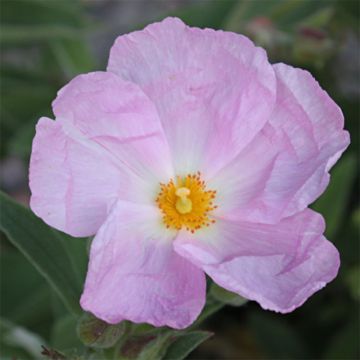
Available in 1 sizes
Available in 1 sizes
According to the colour of the foliage
Proud representatives of Mediterranean bushes, cistus plants bear branches with evergreen foliage, sometimes small and sticky, sometimes broader and fluffy depending on the species or varieties. It is partly the appearance of these thick leaves that allows these shrubs to withstand drought remarkably, as they are designed to limit the plant’s evapotranspiration. Most cistus plants have dark green, rather crinkled foliage. Cistus corbariensis ‘Rospico’, a French cultivar, features a dense habit and pure white flowers with a golden yellow centre, enhanced by deep green foliage, marginate with bright cream. Cistus albidus, known as the Cottony Cistus, showcases its greyish, fluffy, crinkled foliage to enhance borders.

Detail of the leaves of Cistus monspeliensis, Cistus corbariensis ‘Rospico’ and Cistus albidus
According to the flowering period
Cistus are among the first shrubs to bloom, heralding the return of spring. Some only flower at this time, while others take over until the height of summer. This allows for delightful combinations to extend the enjoyment of their flowering!
- The earliest
For white flowers from the end of winter or very early spring: Cistus corbariensis and Cistus corbariensis ‘Rospico’, Cistus salviifolius, Cistus (x) loretii or Cistus Alan Fradd and Cistus monspeliensis. For pale pink flowers: Cistus skanbergii. And for bright pink flowers: Cistus purpureus. Most other varieties take over in May-June for a more or less prolonged flowering.
- The summer bloomers
The summer-flowering cistus include Cistus pulverulentus, Cistus pulverulentus ‘Sunset’ and Cistus purpureus ‘Betty Taudevin’ whose bright pink flowering lasts from May to July. Many trees and shrubs with summer blooms can happily combine with their abundant large flowers. The pink of their corollas harmonises with white, light pink, or lavender blue and can also highlight lovely conifers that adapt to the same growing conditions.
According to its hardiness
Important criterion to consider when choosing your Cistus: hardiness. Depending on the climate of your region and the location where you wish to plant them in your garden, orient your choice according to their cold resistance. Remember: they are Mediterranean plants, and if you wish to create a flowering bed reminiscent of the South, it is better to provide them with the right conditions and full sun!
- Less hardy Cistus
As worthy representatives of Mediterranean flora, Cistus can have variable cold resistance. Cistus creticus and Cistus Montpellierensis are quite tender and will only exceptionally withstand temperatures below -5°C. However, they remarkably tolerate drought in well-drained soil and sea spray!
- Cistus hardy down to -10°C
Most of the Cistus in our selection are relatively cold-resistant. Temperatures around -10°C leave them unscathed, unless the soil is heavy and tends to retain moisture. Therefore, always consider drainage at the time of planting.
- Cistus hardy down to -15°C
Cistus from the Corbières Cistus corbariensis and Cistus corbariensis ‘Rospico’, both white, have increased resistance of up to -15°C, as does the hybrid Cistus argenteus ‘Peggy Sammons’. These three hardy shrubs are champions of resilience: drought, scorching sun, cold, salty wind, poor soils… they fear nothing!
- Subscribe!
- Contents

































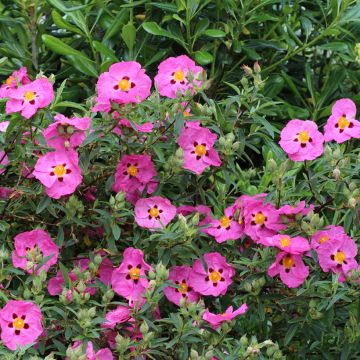

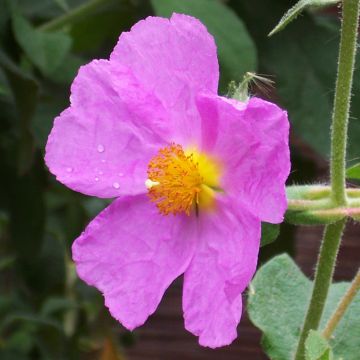

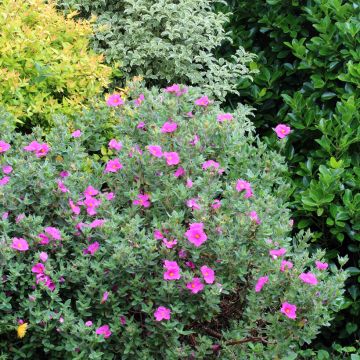
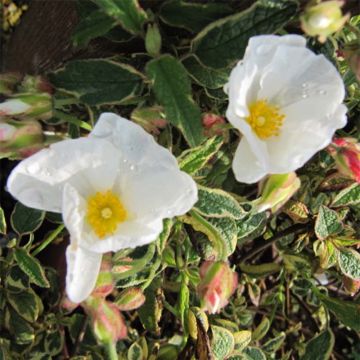
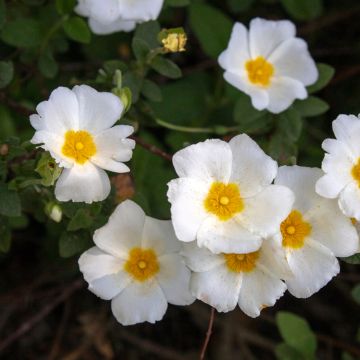

Comments